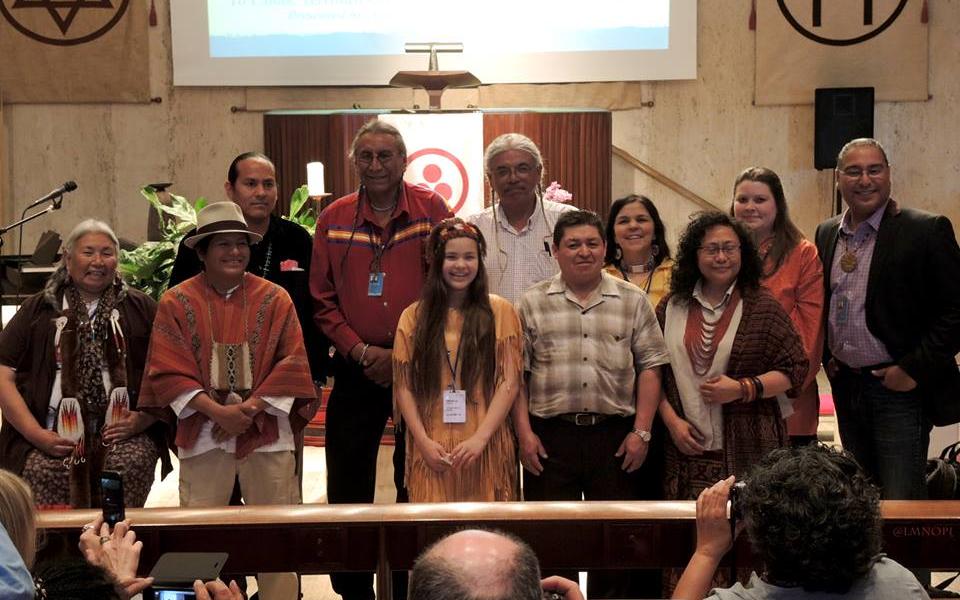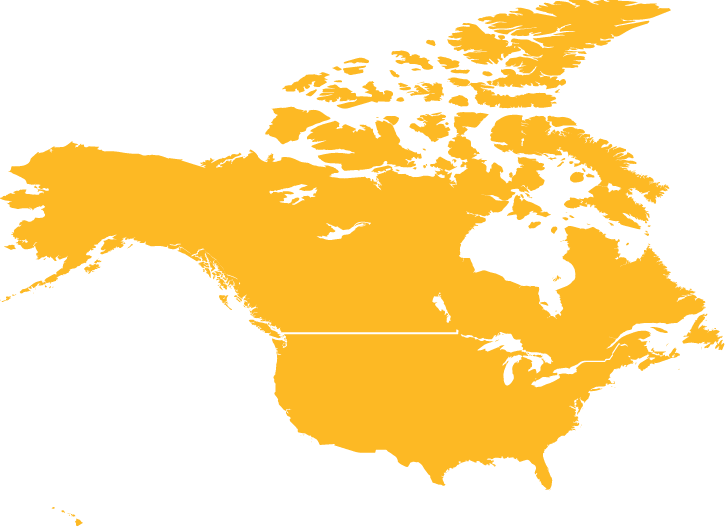
Protecting and Restoring the Sacred, under the guidance of First Peoples Cultural, Spiritual and Legal Heritage Keepers, held an event at Tillman Chapel at the Church Center for the United Nations.
Audri Scott Williams, Rebecca Tobias and Monica Willard provided this report:
The Tillman Chapel at the Church Center was filled by people attending the Permanent Forum on Indigenous issues on May 13. They gathered at this sacred place for a heart-filled, informative, and historic event "Protecting and Restoring Sacred Sites Under the Guidance of First Peoples Cultural, Spiritual and Legal Heritage Keepers."
The Sacred Opening, led by Chief Arvol Looking Horse, 19th Generation Keeper of the White Buffalo Calf Pipe Bundle, Sioux Nation-Lakota, Dakota and Nakota tribes, had participants from the Four Directions offering prayers and song. Oscar Santillin from Ecuador played the Condor feather flute. Donna Augustine Thunderbird Turtle Woman, Mi’kmaq, offered a prayer from the North. Yoland Trevino from the Mayan Confederacy offered a prayer from the South. The East was represented by Maria Laya-Smith, Filipina Babaylan, on behalf of the Indigenous Peoples of the Philippines. Ta`Kaiya Blaney, Sliammon Nation, BC, Canada represented the North. This ceremony opened our hearts so we could be fully present to not only listen to the presentations to come, but to hear at a very deep level both spoken and unspoken wisdom.
The panel focused on Protecting and Restoring Sacred Sites and provided an opportunity for us to connect from the most ancient inclusive sense of the Sacred—ALL Relations/All things Sacred. Some of the sacred sites are physical markers connecting Mother Earth and the stars. Others are burial grounds and places of ceremony. We listened to story and dream weaving teachings about the meaning of sacred sites, not as just a memory but as a guide for the future.
Today’s threats to the Sacred—manifesting in the disregard of and destruction of Sacred Sites throughout the Americas— include a variety of problems such as the lack of appreciation for Sacred Sites, lack of laws or disregard of laws to protect these sites, climate change, and the extractive industries buying land that contains or threatens sacred sites.
Chief Arvol Looking Horse offered prayers for the Ancestors of Nations in Lakota language, and spoke of the awakening taking place uniting People of the Earth to act and pray together for global healing. Since 1994, Chief Looking Horse has journeyed in this vision, holding World Peace and Prayer Day at sacred sites globally on June 21st, encouraging people to step forward in recognizing the value of their own cultural roots and, in so doing, reconnecting with the strengths and wisdom which all traditional cultures hold in common: our connection to each other and to the Earth.
Chief Looking Horse addressed the panel in a meaningful call for the United Nations to formally establish June 21st as International Sacred Sites and Cultural Heritage Day, recalling his ongoing efforts, and asking for sponsors and support.
Honor Keeler, JD, Chair, Association on American Indian Affairs Working Group on International Repatriation, spoke to historic and present day human rights issues affecting current tribal, national, and international efforts to repatriate ancestral remains and cultural and ceremonial artifacts.
Tim Mentz Sr., Makoche Wowapi Environmental/Cultural Resource Consultant, Standing Rock Sioux Tribe Tribal Historic Preservation Officer, revealed his tribal findings of an ancient sacred site that has been destroyed, but the spirit of it and the teachings live on. The Elders, with great care, are determining the best way to bring the teachings back to the people.
Fourteen year-old Ta`Kaiya Blaney, URI Youth Ambassador on the Environment to the UN, made it very clear why this work is critical. She represents the generation that is facing the reality that the ways of the ancestors are gone. Things like drinking and fishing from the sea/rivers, speaking the languages, and learning the values and teachings are gone or greatly diminished. Now is the time to do all that we can to protect and to reach the youth. Her Sliammon Nation is on the brink of dissolving and giving all rights as a sovereign nation to Canada. They are currently about to lose 97% of their land in exchange for payment from the government.
Shawn Mulford, Navajo/Dine Sacred Sites Traditional Knowledge Keeper, showed us footage from a video of tribal elders in a National Park attempting to do a sacred fire ceremony. The National Park police asked them to put out their sacred fire. The Indigenous said it was their human right to practice their religion on their land and offered neither help or resistance as the ranger put out their sacred fire. This simple video clip provided a clear example of the difference between conservation (conserving something that was) and preservation of sacred sites (preserving something that is still “alive” and for the People).
Donna Augustine Thunderbird Turtle Woman of the NAGPRA Review Committee spoke of her connection with the ancestors and the sacredness of burial sites. By sharing the facts that modern day burial grounds are protected and ancient native burial grounds are being destroyed, she conveyed the pain felt by the indigenous peoples as well as the purpose for protecting these sites. Her beautiful unity song touched our hearts as the native words were sung to the beating of her drum.
Monica Willard, URI UN Representative, made short presentations on recognized symbols used to protect sacred sites. The Blue Shield is a little known protective sign used to mark cultural sites during armed conflict. It was created in The 1954 Hague Convention, adopted by UNESCO, and is currently recognized by 126 member states. The Roerich Culture of Peace Banner is another symbol used for the protection of artistic and scientific institutions and historic monuments. The USA and other Inter-American Republics signed the treaty to recognize the banner in 1935.
Rebecca Tobias, URI Global Council Secretary and Trustee, designed the panel Protecting and Restoring Sacred Sites Under the Guidance of First Peoples Cultural, Spiritual and Legal Heritage Keepers to discuss the importance of sacred sites and to ask what is currently being done to protect and restore them. She also knew that the Blue Shield and the Roerich Banner are legally recognized symbols designed to offer rules of engagement, standards and safeguards to protect cultural heritage and sacred sites during times of conflict, as both emblems have often been referred to as the, ‘Red Cross of culture.’ She asked the questions: If sites can be marked as protected during times of war, how can these protections be broadened to safeguard them when threatened by other human-wrought disasters like climate change, urbanization and industrial development? How can cooperation be strengthened between Traditional Knowledge Keepers and UNESCO in shared effort, to chronicle and maintain the spiritual integrity of sacred spaces? How can Indigenous Peoples be afforded unimpeded access to ancestral ceremonial sites for the purpose of prayer and ceremony out of respect for their human rights? Although Rebecca was not able to attend this special event, her vision, wisdom, questions and hard work made it a well attended and appreciated event.
The event was moderated by Roberto Borrero, (Taino) Chair of the NGO Committee on the International Decade of the World’s Indigenous Peoples. Sponsors of the event were: United Religions Initiative (URI), Wodakota Foundation, Protecting and Restoring the Sacred CC, Wittenberg Center for Alternative Resources, United Confederation of Taino People, Tribal Link, and the NGO Committee on Sustainable Development. Special thanks go to URI members who helped with this event: Betsy Stang, Debbra Gill, Sande Hart, Audri Scott Williams (Interim Coordinator of the URI Indigenous Initiative) and to Yoland Trevino, who served as URI Global Council Chair from 2005-2012.
The day ended with the Teach-In presented by Faith Spotted Eagle, Ihanktonwan Brave Heart Elder, on coalition building. She is a key organizer of the, “Reject and Protect” ‘Cowboy and Indian Alliance’ which was recently in Washington, DC. The potentially devastating environmental impact of the Keystone XL Pipeline is the catalyst for this unprecedented unified action of tribes, ranchers and citizens of many nations. She reminded us that organizing for change requires renegotiation every step of the way. She pointed out...the true challenge of closed systems (colonial constructs) and the need for open systems (indigenous constructs). She is also establishing Peace Camps along the path of the projected Keystone XL Pipeline to use indigenous ceremonies and nonviolent training to build a bigger coalition of well trained activists to stop the pipeline and protect the Earth.
